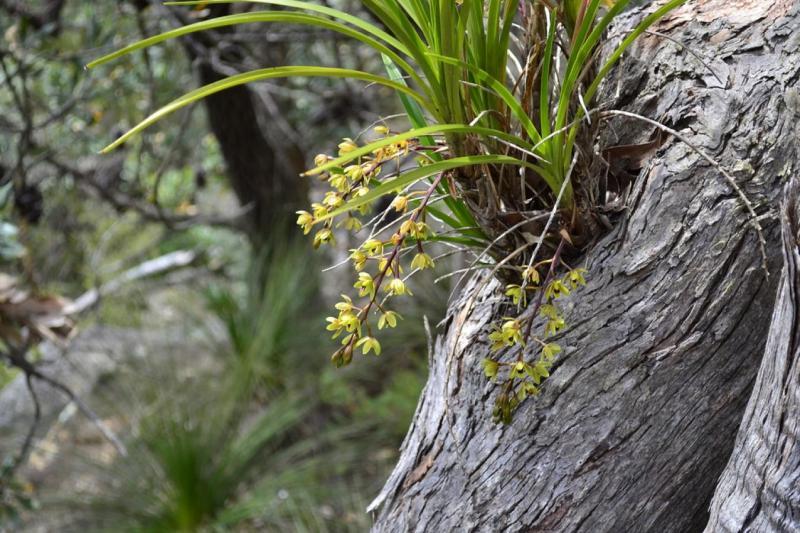Cymbidium suave
Also known as: Snake Flower in the subfamily: Epidendroideae
General Information
Snake Flower is a miniature cool to warm growing epiphytic orchid belonging to the sub family Epidendroideae.
Plant Description
Grows to 30-60cm. Each new growth has numerous arching leaves that grow to 0.8-60cm long. Pseudobulbs grow to 50cm
Flowers
Numerous fragrant blossoms appear during Winter and Spring
Fragrance
The orchid is fragrant. The fragrance can be described as strong and sweet
Blooming Season
- Spring
- Winter
Substrate(s)
- Medium
- Fine
- Bark
- Charcoal
Care Notes
This orchid goes into a dormancy phase during winter, during this phase it is best not to provide water unless the plant is starting to look thirsty. The lack of water increases the chance of flowering in spring, and also reduces the likelihood of any rot forming. Do not resume watering until new growth has appeared and is growing strongly.
Often a period of intense growth occurs after dormancy. During this time the amount of light, water and fertiliser the plant receives will directly impact the amount of growth that occurs during this time, and in the case of seedlings, will reduce the time required to reach maturity.
It's recommended to heavily reduce the water amount at the middle to end of autumn to trigger dormancy. Leaves on older bulbs will begin to drop during this time while the newer bulbs continue to mature until terminal leaves appear at the tip of the pseudobulbs.
Repotting can be done any time of the year though it's best to do it in early spring when new growth is appearing as this also means new roots will appear to help the plant anchor into the new media and offset any damage to established roots during the repotting process.
Fragrant:
- IsFragrant
Climate
These orchids grow in cool climates, at low altitudes, in cool plains, forests or coastal scrub.
They are forgiving of humidity variances as long as temperatures are kept on the cool side. They can do well outdoors in the garden in cool and temperate areas, though it is important that they are protected from warm dry winds. They can enjoy morning sun especially in winter but will need protection from the hot sun in the afternoon and during summer. With some acclimatisation they may be able to receive more sun.
Grows at low to high elevations. Rainfall ranges from 48mm to 163mm per day, heaviest in July and lightest in February. Humidity ranges from 57% to 66%, highest in September and lowest in April. Temperature ranges from 6C to 26C, highest in June (17C to 26C) and lowest in January (6C to 16C).
Watering
These orchids prefer a constant supply of moisture, with a slight drying out between waterings. Saucers can be placed under pots to retain moisture during hot weather, however the saucers should be removed or let to dry every 1-2 weeks to prevent rot. Keep an eye on the plant especially in hot weather and look for cues of under/overwatering and adjust accordingly.
Fertiliser
These orchids do not need to be regularly fertilised and roots may be sensitive to salt build-up, dying back and therefore impairing the plants growth or even killing it.
If fertilising, use half to quarter of the recommended amount of fertiliser. If they receive fertiliser as part of a collection, be sure to flush out the pots regularly with fresh water and monitor the roots by checking how much resistance is given by the plant when nudged in its pot or mount. If the plant becomes wobbly or loose, repot in fresh mix or rinse the media/mount thoroughly and do not fertilise for at least 3 months.
Be sure to flush out excess fertiliser by running water through the media regularly year round. This plant is sensitive so apply fertiliser sparingly at one quarter recommended strength or less. Use a high Nitrogen fertiliser year round. Use a low Nitrogen fertiliser during Winter. Use a high Phosphorous fertiliser year round.Potting
It's best to observe the root system when repotting and use that as a guide:
A plant with a short root system will do better in a shallower pot with a fine mix, or mounted on fern or cork supplanted with a good amount of moss or similar material.
A plant with a long root system often does well in a pot filled with moss or fine media, mixing in perlite and charcoal is always beneficial to reduce the likelihood of the mix becoming soggy and keeps it fresh.
A plant with a coarser long root system can be potted in a deeper pot, but with 2/3 coarse material such as bark, expanded clay, or coco chips and topped with moss or similar material. This will allow the moisture to remain inside the pot but give the roots air as well.
This plant does very well in baskets or suspended pots Repotting is best done annually.




















